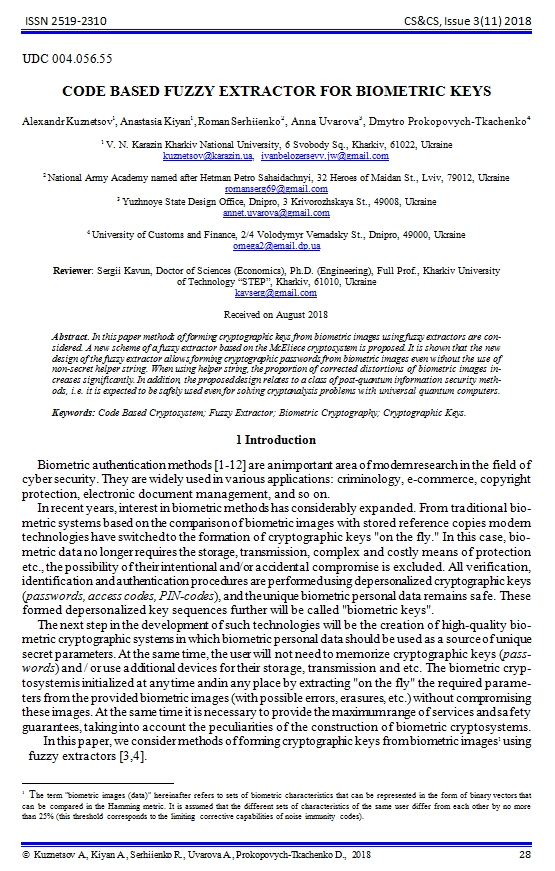Code based fuzzy extractor for biometric keys
Abstract
In this paper methods of forming cryptographic keys from biometric images using fuzzy extractors are considered. A new scheme of a fuzzy extractor based on the McEliece cryptosystem is proposed. It is shown that the new design of the fuzzy extractor allows forming cryptographic passwords from biometric images even without the use of non-secret helper string. When using helper string, the proportion of corrected distortions of biometric images increases significantly. In addition, the proposed design relates to a class of post-quantum information security methods, i.e. it is expected to be safely used even for solving cryptanalysis problems with universal quantum computers.
Downloads
References
Hao F., Anderson R., Daugman J. Combining cryptography with biometrics effectively: Technical Report UCAM-CL-TR-640. Cambridge: University of Cambridge Computer Laboratory, 2005. 17 p.
Juels A., Sudan M. A fuzzy vault scheme. Des. Codes Cryptography. 2006. Vol. 38, № 2. pp. 237–257.
Fuzzy extractors: How to generate strong keys from biometrics and other noisy data /Dodis Y., Ostrovsky R., Reyzin L., Smith A. D. SIAM J. Comput. 2008. Vol. 38, № 1. pp. 97–139.
Dodis Ye., Reyzin L., Smith A. Fuzzy Extractors. A Brief Survey of Results from 2004 to 2006. URL: http://www.cs.bu.edu/~reyzin/papers/fuzzysurvey.pdf
Cryptographie key generation from PUF data using efficient fuzzy extractors/ Kang H., Hori Y., Katashita T., Hagiwara M. Iwamura K. 16th International Conference on Advanced Communication Technology. 2014, Pyeongchang. pp. 23–26.
Fuzzy Extractors for Biometric Identification / Li N. and etc. 2017 IEEE 37th International Conference on Distributed Computing Systems (ICDCS). 2017, Atlanta, GA. pp. 667–677.
Wen Y., Lao Y. Efficient fuzzy extractor implementations for PUF based authentication. 12th International Conference on Malicious and Unwanted Software (MALWARE). 2017, Fajardo. pp.119–125.
Kaur T., Kaur M. Cryptographic key generation from multimodal template using fuzzy extractor. 2017 Tenth International Conference on Contemporary Computing (IC3). 2017, Noida. pp. 1–6.
Gupta N. K. and Kaur M. A robust and secure multitrait based fuzzy extractor. 2017 8th International Conference on Computing, Communication and Networking Technologies (ICCCNT). 2017, Delhi. pp. 1–6.
LWE-based lossless computational fuzzy extractor for the Internet of Things / Huth C. D. and etc. 2017 IEEE International Symposium on Hardware Oriented Security and Trust (HOST). 2017, McLean, VA. P. 154.
Securing Systems With Indispensable Entropy: LWE-Based Lossless Computational Fuzzy Extractor for the Internet of Things / Huth C. and etc. IEEE Access. 2017. Vol. 5. pp. 11909–11926.
Eliminating Leakage in Reverse Fuzzy Extractors / Schaller A., Stanko T., Škorić B. and Katzenbeisser S. IEEE Transactions on Information Forensics and Security. 2018. Vol. 13, № 4. pp. 954–964.
McEliece R. J. A public-key cryptosystem based on algebraic coding theory. DSN Progress Report 42-44, Jet Propulsion Lab. 1978, Pasadena, CA. pp. 114–116.
Clark G.C., Cain J.B. Error-Correction Coding for Digital Communications. Springer, 1981. 432 p.
Blahut R. E. Theory and Practice of Error Control Codes. Massachusetts: Addison Wesley Publishing Company Inc., 1983. 500 p.
Code-based electronic digital signature/ Kuznetsov A., Pushkar'ov A., Kiyan N., Kuznetsova T. 2018 IEEE 9th International Conference on Dependable Systems, Services and Technologies (DESSERT). 2018. Kyiv. pp. 331–336.
Goppa V.D. A New Class of Linear Correcting Codes. Problems Inform. Transmission. 1970. Vol. 6, № 3. pp. 207–212.
Bernstein D., Buchmann J., Dahmen E. Post-Quantum Cryptography. Berlin-Heidleberg : Springer-Verlag, 2009. 245 p.


